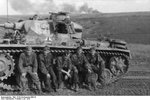parsifal
Colonel
Well, time to stick my two cents worth in.......I dont believe the german Infantry was up to a mobile defence at all. By 1943, the mobility of german Infantry was about half that what it was due to the losses in trucks and horses. Every time they were called upon to undertake a major march, the losses went through the roof, particualrly in terms of equipment.
In contrast the Soviet Infantry was going from strength to strength in terms of its mobility, thanks to the 350000 trucks supplied under LL. And whilst the SS and the Panzers generally were an essential attacking arm (whether that be a defensive counterattack, or a full on offensive, they needed the Infantry to fill the gaps and absorb the punishment, otherwise they took inordinate losses themselves.
Manstein, before he got this cockamamie idea of mobile defence realized that the only real hope was to make short withdrawals of twenty to twenty five kilometres to avoid the devastating effects of the Soviet artillery. The key to the German defences wasnt the Infantry ofr the tanks so much, as the ability to avoid the dislocation from the enemy artillery, and to concentrate ones own artillery sufficiently to have a significant effect. These "last minute short legged withdrawals would have been entirely possible along limited sections of the front, because it would have allowed the dweindling supply of MT in the Heer to be pooled wher necessary. Leaving it to the last minute was entirely plausible as well, given the ecellent intelligence work being done by that stage by Gehlen and his staff.
But the wholseale withdrawal from the entire front was a pipe dream and a recipe for disaster, given the parlous state of the German logistics arm by that stage of the war
In contrast the Soviet Infantry was going from strength to strength in terms of its mobility, thanks to the 350000 trucks supplied under LL. And whilst the SS and the Panzers generally were an essential attacking arm (whether that be a defensive counterattack, or a full on offensive, they needed the Infantry to fill the gaps and absorb the punishment, otherwise they took inordinate losses themselves.
Manstein, before he got this cockamamie idea of mobile defence realized that the only real hope was to make short withdrawals of twenty to twenty five kilometres to avoid the devastating effects of the Soviet artillery. The key to the German defences wasnt the Infantry ofr the tanks so much, as the ability to avoid the dislocation from the enemy artillery, and to concentrate ones own artillery sufficiently to have a significant effect. These "last minute short legged withdrawals would have been entirely possible along limited sections of the front, because it would have allowed the dweindling supply of MT in the Heer to be pooled wher necessary. Leaving it to the last minute was entirely plausible as well, given the ecellent intelligence work being done by that stage by Gehlen and his staff.
But the wholseale withdrawal from the entire front was a pipe dream and a recipe for disaster, given the parlous state of the German logistics arm by that stage of the war

